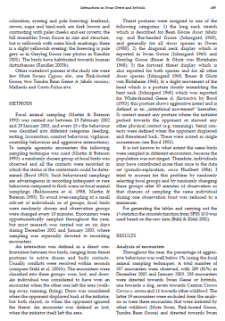- Wyszukaj w całym Repozytorium
- Piśmiennictwo i mapy
- Archeologia
- Baza Młynów
- Nauki przyrodnicze
Wyszukiwanie zaawansowane
Wyszukiwanie zaawansowane
Wyszukiwanie zaawansowane
Wyszukiwanie zaawansowane
Wyszukiwanie zaawansowane

Obiekt
Tytuł: Ground nesting in recultivated forest habitats - a study with artificial nests
Twórca:
Purger, Jenö J. (1961– ) ; Mészáros, Lídia Anna ; Purger, Dragica ; Polska Akademia Nauk. Muzeum i Instytut Zoologii
Data wydania/powstania:
Typ zasobu:
Inny tytuł:
Acta Ornithologica, vol. 39, no. 2 ; Presja drapieżników na lęgi ptaków gniazdujących na ziemi na terenach objętych rekultywacją - badania przy użyciu sztucznych gniazd ; Artificial ground nest survival
Współtwórca:
Museum and Institute of Zoology, Polish Academy of Sciences
Wydawca:
Miejsce wydania:
Opis:
Bibliogr. s. 144-145 ; S. [137]-145 : il. ; 27 cm ; Streszcz. pol. Nazwy taksonów także w jęz. łac.
Typ obiektu:
Abstrakt:
The study was carried out in the outskirts of the town of Pécs (southern Hungary) in a recultivated former coal mine. Bordered by Turkey Oak forests, this open area forms a wedge-shaped clearing in that woodland. Since trees and taller shrubs are rare in the area, it is mainly ground nesting bird species that occur in the clearing. In order to discover whether it is more advantageous to nest in the recultivated area (clearing) than in the nearby forest or at its edges, 150 artificial ground nests were constructed. On 7 May 2002, one quail egg and a plasticine egg of similar size were placed in each of the artificial nests. After a week it was found that 24% of nests in the clearing, 30% of those in the forest edge, and 44% of the ones inside the forest had suffered depredation. The proportions of damaged plasticine and quail eggs inside the forest and at the forest edge were similar, whereas the quail eggs in the clearings were significantly less damaged than plasticine eggs. Of all the experimental eggs, significantly more plasticine eggs (29%) were damaged than quail eggs (17%), which suggests that small-bodied predators are unable to break the quail eggs. 18% of the plasticine eggs attacked, and 72% of the quail eggs attacked were removed from the nest by the predator. Among the predators, small mammals were dominant in the clearing and inside the forest, and birds at the forest edge. Based on the predation of quail eggs, the survival chances of ground nests in the clearing are greater than at the forest edge or inside the forest.
Czasopismo/Seria/cykl:
Tom:
Zeszyt:
Strona pocz.:
Strona końc.:
Szczegółowy typ zasobu:
Format:
Identyfikator zasobu:
Źródło:
MiIZ PAN, sygn. patrz sygn. czas. P.257-39-2 ; MiIZ PAN, sygn. patrz sygn. czas. P.4568-39-2 ; kliknij tutaj, żeby przejść
Język:
Prawa:
Prawa zastrzeżone - dostęp nieograniczony
Zasady wykorzystania:
Digitalizacja:
Muzeum i Instytut Zoologii Polskiej Akademii Nauk
Lokalizacja oryginału:
Biblioteka Muzeum i Instytutu Zoologii PAN
Dostęp:
Kolekcje, do których przypisany jest obiekt:
- Repozytorium Cyfrowe Instytutów Naukowych > Kolekcje Partnerów > Muzeum i Instytut Zoologii PAN > Czasopisma
- Repozytorium Cyfrowe Instytutów Naukowych > Kolekcje Partnerów > Muzeum i Instytut Zoologii PAN > Wydawnictwa MiIZ PAN > Acta Ornithologica
- Repozytorium Cyfrowe Instytutów Naukowych > Piśmiennictwo > Czasopisma/Artykuły
Data ostatniej modyfikacji:
2 paź 2020
Data dodania obiektu:
28 lip 2015
Liczba pobrań / odtworzeń:
36
Wszystkie dostępne wersje tego obiektu:
https://rcin.org.pl./publication/49784
Wyświetl opis w formacie RDF:
Wyświetl opis w formacie RDFa:
Wyświetl opis w formacie OAI-PMH:
| Nazwa wydania | Data |
|---|---|
| Ground nesting in recultivated forest habitats — a study with artificial nests / Purger J. J., Mészáros L. A. | 2 paź 2020 |
Obiekty Podobne
Wysocki, Dariusz (1961– ) Polska Akademia Nauk. Muzeum i Instytut Zoologii
Antonov, Anton (1977–2012) Polska Akademia Nauk. Muzeum i Instytut Zoologii
Mazgajski, Tomasz D.
Báldi, András (1965– ) Batáry, Péter
Wysocki, Dariusz
Winton, Bryan Reno Leslie, David M.
Walankiewicz, Wiesław
Poulin, Brigitte (1962– ) Lefebvre, Gaëtan (1962– ) Metref, Slimane

 INSTYTUT ARCHEOLOGII I ETNOLOGII POLSKIEJ AKADEMII NAUK
INSTYTUT ARCHEOLOGII I ETNOLOGII POLSKIEJ AKADEMII NAUK
 INSTYTUT BADAŃ LITERACKICH POLSKIEJ AKADEMII NAUK
INSTYTUT BADAŃ LITERACKICH POLSKIEJ AKADEMII NAUK
 INSTYTUT BADAWCZY LEŚNICTWA
INSTYTUT BADAWCZY LEŚNICTWA
 INSTYTUT BIOLOGII DOŚWIADCZALNEJ IM. MARCELEGO NENCKIEGO POLSKIEJ AKADEMII NAUK
INSTYTUT BIOLOGII DOŚWIADCZALNEJ IM. MARCELEGO NENCKIEGO POLSKIEJ AKADEMII NAUK
 INSTYTUT BIOLOGII SSAKÓW POLSKIEJ AKADEMII NAUK
INSTYTUT BIOLOGII SSAKÓW POLSKIEJ AKADEMII NAUK
 INSTYTUT CHEMII FIZYCZNEJ PAN
INSTYTUT CHEMII FIZYCZNEJ PAN
 INSTYTUT CHEMII ORGANICZNEJ PAN
INSTYTUT CHEMII ORGANICZNEJ PAN
 INSTYTUT FILOZOFII I SOCJOLOGII PAN
INSTYTUT FILOZOFII I SOCJOLOGII PAN
 INSTYTUT GEOGRAFII I PRZESTRZENNEGO ZAGOSPODAROWANIA PAN
INSTYTUT GEOGRAFII I PRZESTRZENNEGO ZAGOSPODAROWANIA PAN
 INSTYTUT HISTORII im. TADEUSZA MANTEUFFLA POLSKIEJ AKADEMII NAUK
INSTYTUT HISTORII im. TADEUSZA MANTEUFFLA POLSKIEJ AKADEMII NAUK
 INSTYTUT JĘZYKA POLSKIEGO POLSKIEJ AKADEMII NAUK
INSTYTUT JĘZYKA POLSKIEGO POLSKIEJ AKADEMII NAUK
 INSTYTUT MATEMATYCZNY PAN
INSTYTUT MATEMATYCZNY PAN
 INSTYTUT MEDYCYNY DOŚWIADCZALNEJ I KLINICZNEJ IM.MIROSŁAWA MOSSAKOWSKIEGO POLSKIEJ AKADEMII NAUK
INSTYTUT MEDYCYNY DOŚWIADCZALNEJ I KLINICZNEJ IM.MIROSŁAWA MOSSAKOWSKIEGO POLSKIEJ AKADEMII NAUK
 INSTYTUT PODSTAWOWYCH PROBLEMÓW TECHNIKI PAN
INSTYTUT PODSTAWOWYCH PROBLEMÓW TECHNIKI PAN
 INSTYTUT SLAWISTYKI PAN
INSTYTUT SLAWISTYKI PAN
 SIEĆ BADAWCZA ŁUKASIEWICZ - INSTYTUT TECHNOLOGII MATERIAŁÓW ELEKTRONICZNYCH
SIEĆ BADAWCZA ŁUKASIEWICZ - INSTYTUT TECHNOLOGII MATERIAŁÓW ELEKTRONICZNYCH
 MUZEUM I INSTYTUT ZOOLOGII POLSKIEJ AKADEMII NAUK
MUZEUM I INSTYTUT ZOOLOGII POLSKIEJ AKADEMII NAUK
 INSTYTUT BADAŃ SYSTEMOWYCH PAN
INSTYTUT BADAŃ SYSTEMOWYCH PAN
 INSTYTUT BOTANIKI IM. WŁADYSŁAWA SZAFERA POLSKIEJ AKADEMII NAUK
INSTYTUT BOTANIKI IM. WŁADYSŁAWA SZAFERA POLSKIEJ AKADEMII NAUK


































